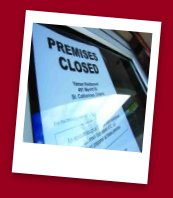|
Restaurant Inspections:
|
|
|
Every state in the U.S. the health department has a system of inspections for restaurants, hotels, grocery stores, and other places that handle food. The way these health inspections are conducted varies from state to state but, throughout the nation, health departments inspect these places and issue reports of what they find.
 The good news? These reports are public knowledge, and can be read by any interested citizen.
The good news? These reports are public knowledge, and can be read by any interested citizen.
Why should you check out these reports? When you go to a restaurant or any other food service establishment, all you usually see is the dining area, where you sit. But health department reports give you an inside look at the kitchen, where the main activity takes place.
To find out how to access your local health department inspections, click here.
According to FDA rules, all locations should be visited at least two to four times a year. Depending on where you live, food service locations are visited from one to eight times a year. An inspector arrives at a facility without advance notice. He/she checks out cooking and food-holding temperatures… how foods are prepared and stored… how clean the kitchen is while cooking is going on… how clean the employees are. If the kitchen and the people in it don’t meet health department standards, the restaurant gets a lower overall score.
 This inspection has teeth in it, too. The health department can require a location to fix their coolers, train their staff about proper hand washing, clean up areas that don’t meet the standard, eliminate mice or bugs, and much more. This means that you, the consumer, can feel safer eating there.
This inspection has teeth in it, too. The health department can require a location to fix their coolers, train their staff about proper hand washing, clean up areas that don’t meet the standard, eliminate mice or bugs, and much more. This means that you, the consumer, can feel safer eating there.
However, health department inspections can be very difficult to understand. You will want to know how to read one. Click here for more details.
In some states, facilities get grades from the health department. If you live in some parts of California, for example, you can tell by a sign on the restaurant’s front door or window how clean the kitchen is. If the sign has an “A,” you can trust the food and the preparation. A lower grade means the place is riskier; owners say that a “B” or “C” is the kiss of death for their businesses.
In extreme cases – very serious problems, or problems not fixed since the last inspection – the health department can fine the facility, require the management to work with food safety specialists, or even close the place down.
So what’s in this for you? Reviewing these inspection reports gives you the inspector’s view of the kitchen. You’ll know what risks you take as you order your food. More good news: If you have a bad experience at a restaurant or other food-handling facility, contact your local health department and tell them about it . They may want to investigate.
To find out how to find health inspections for your locality, click here.
If you want to know what Red Flags to look out for at a restaurant, click here.
To find out how food can go bad, click here.
To ask a question of our experts, click here.






